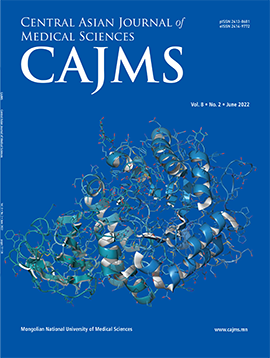Selective Internal Radiation Therapy (SIRT) Versus Sorafenib in Mongolian Patients with Advanced Hepatocellular Carcinoma: A Subgroup Analysis of the SIRveNIB Study
DOI:
https://doi.org/10.24079/cajms.2019.09.005Keywords:
RECIST, SIRT Selective Internal Radiation Therapy, Alanine Aminotransferase, Aspartate AminotransferaseAbstract
Objective: The purpose of this study was to compare the efficacy and safety of selective internal radiation therapy and sorafenib on advanced hepatocellular carcinoma. Methods: The National Cancer Center of Mongolia was one of the Asia-Pacific Liver Cancer Research Team sites, and we recruited patients into the study. Patients were randomly assigned 1:1 stratified and to receive either SIRT or sorafenib 800 mg/d orally. Outcome measures were physical examination, functional assessment, CBC, liver function test, AFP results, and CT scan every 4, 8 and, 12 weeks after treatment initiation. Results: Between March 2011 and June 2016, 39 patients were enrolled in the study. Twenty patients were treated with SIRT, and 19 patients were treated with sorafenib. Median OS and PFS rates were no different in sorafenib arm patients than in SIRT arm (15.56 vs. 9.17; HR 0.95, 95% CI 0.46, p = .889) and (8.51 months vs. 5.85 months; HR,1.07; CI, 0.53-2.16, p = .842). But, tumor response was greater in SIRT than sorafenib treatment (68.8% vs 62.5%, p = .033). Two (10%) patients had a complete response, 2 (10%) patients had a partial response, and 7 (43.8%) patients had a stable response. A total of 165 treatment-emergent adverse events were reported (SIRT 66 vs. sorafenib 99). Significantly fewer patients in the SIRT than sorafenib group had grade ≥3 adverse events (83 vs. 115, p = .0964). Conclusion: In patients with locally advanced hepatocellular carcinoma, overall survival did not differ significantly between SIRT and sorafenib. But SIRT significantly increased tumor response and reduced the incidence of adverse events compared with sorafenib.
Downloads
259
Downloads
Published
How to Cite
Issue
Section
License
Copyright (c) 2019 Mongolian National University of Medical Sciences

This work is licensed under a Creative Commons Attribution-NonCommercial 4.0 International License.




